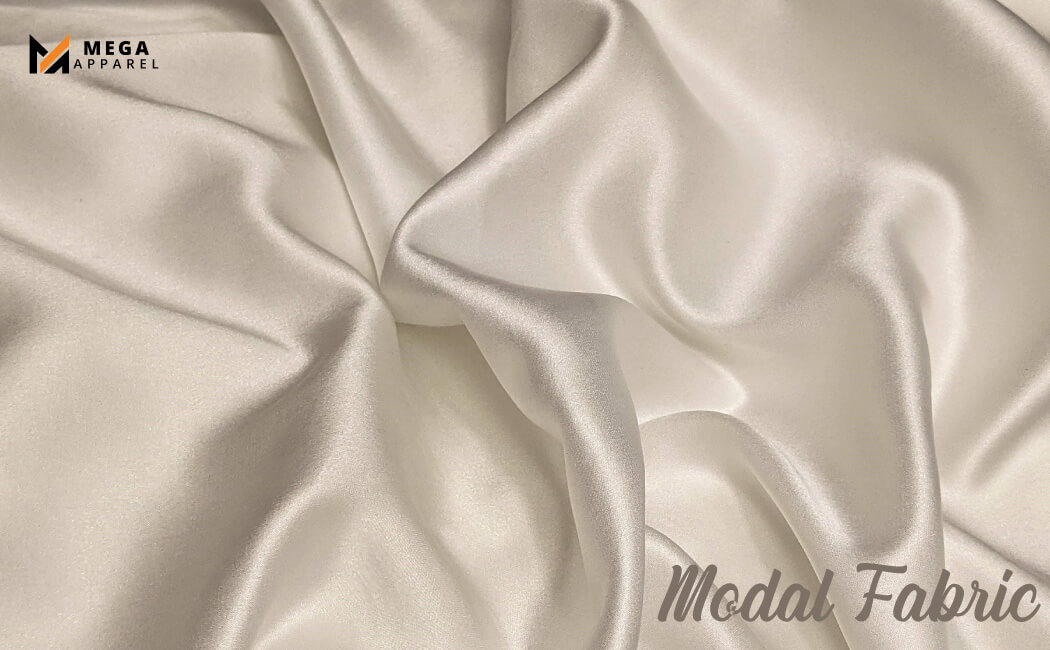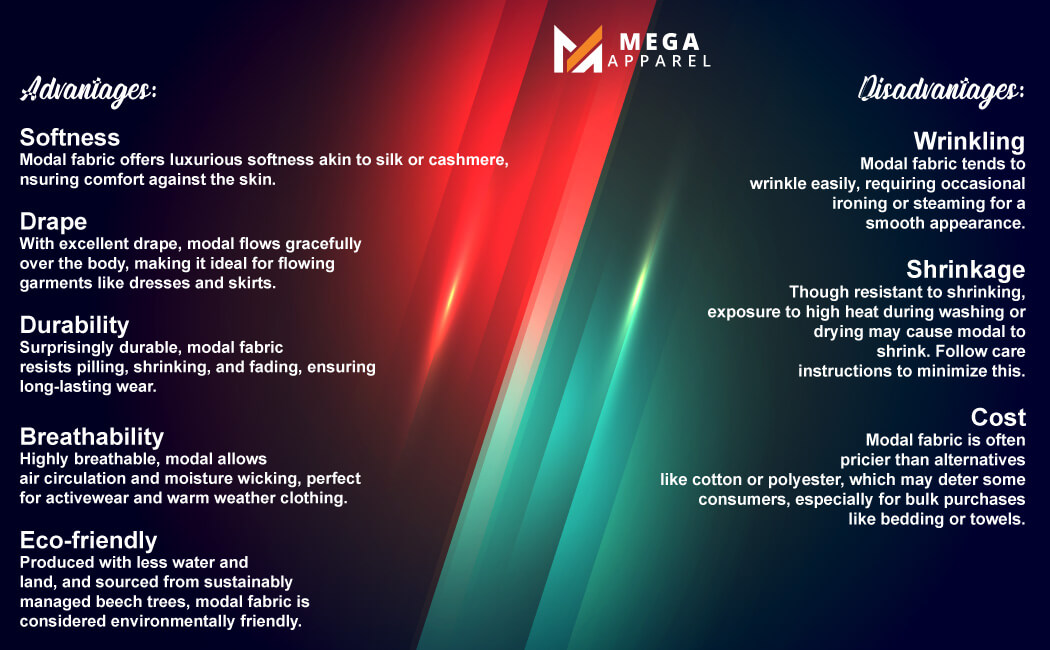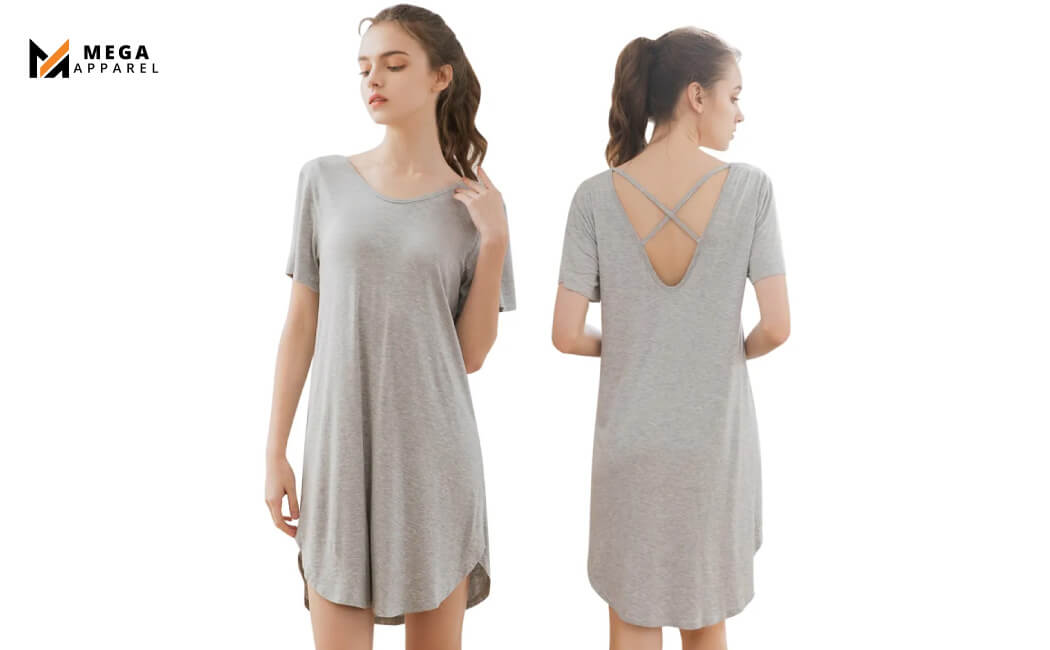Modal fabric is a type of rayon fabric made from the fibers of beech trees. It’s known for its softness, smoothness, and ability to drape well. Modal is often used in clothing such as underwear, pajamas, and active wear due to its breathable and moisture-wicking properties.
It’s also eco-friendly, as the production process requires less water and land compared to cotton, and the beech trees used for modal production are typically sustainably managed.
Significance of Modal Fabric
Some refer to it as the “underwear fabric,” while others just see it as a sustainable textile choice. In any case, modal is transforming the fashion business by using beech tree pulp and making it a sturdy, eco-friendly material for clothes and household items. It is lightweight, elastic, and breathable.
It is a semi-synthetic fabric mostly used for home goods like towels and bed linens as well as apparel like pajamas and underwear.
Modal is a kind of rayon, another textile made from plants; however, it is a little bit more flexible and durable than rayon. For increased strength, modal is frequently mixed with other fibers like spandex and cotton. Given that it is more costly than viscose or cotton and has a softer feel, modal is regarded as an opulent fabric.
Origin and Background
In the 1950s, modal fabric was first created in Japan. The Austrian business Lenzing AG, which owns the fabric’s trademark and produces the majority of modal today under the labels Formatex, China Modal, and Lenzing Modal.
Lenzing offers even lighter variants of the material under the names MicroModal and Modal Air. Since the final result from these variations is softer due to their even finer knitting than that of regular modal, things manufactured from these textiles are regarded as much more opulent.
How is Modal Fabric Manufactured?
The cellulose from beech tree pulp is transformed into fibers in a multi-step process that allows the yarn to be spun, knit, or woven into fabric for modal production. This is a simplified synopsis of the production process:
Harvesting and Pulping
Beech trees are harvested, and the wood chips are broken down into pulp through a chemical process known as pulping. This involves treating the wood chips with chemicals to break down the cellulose fibers.
Extrusion
The cellulose pulp is then extruded through spinnerets, which are small nozzles, to form fibers. These fibers are then stretched to improve their strength and uniformity.
Spinning
The extruded fibers are spun into yarn using spinning machines. This yarn can be used to make modal fabric directly or blended with other fibers like cotton or polyester.
Weaving and Knitting
The yarn is either woven on looms to create woven modal fabric or knitted on knitting machines to produce knit modal fabric. This step determines the texture and appearance of the final fabric.
Finishing
After weaving or knitting, the fabric undergoes finishing processes such as washing, dyeing, and softening to enhance its properties and appearance. These processes can include treatments to improve the fabric’s colorfastness, shrink resistance, and hand feel.
Quality Controller
Throughout the manufacturing process, quality control measures are implemented to ensure that the modal fabric meets the desired specifications for softness, strength, color, and other characteristics.
Overall, the manufacturing of modal fabric involves a combination of mechanical and chemical processes to transform natural cellulose into soft, durable fibers suitable for use in a variety of textile applications.
What Are The Advantages of Modal Fabric?
Modal clothing fabric offers several advantages, including:
1. Softness
Modal material is renowned for its exceptional softness, often described as feeling similar to silk or cashmere. This makes it very comfortable to wear against the skin.
2. Drape
Modal fabric has excellent drape, meaning it hangs gracefully and flows smoothly over the body. This makes it suitable for flowing garments like dresses and skirts.
3. Durability
Despite its softness, modal fabric is surprisingly durable and resistant to pilling, shrinking, and fading. It retains its shape well over time, making it a long-lasting choice for clothing.
4. Breathability
Modal fabric is highly breathable, allowing air to circulate through the fabric and wick moisture away from the skin. This makes it ideal for activewear and clothing worn in warm weather.
5. Eco-friendly
Modal material is often considered more environmentally friendly than conventional cotton, as the production process requires less water and land, and the beech trees used are typically sustainably managed.
What Are The Disadvantages of Modal Fabric?
1. Wrinkling
Modal fabric has a tendency to wrinkle easily, especially when it’s wet. While it’s less prone to wrinkling compared to some other fabrics like linen, it may still require ironing or steaming to maintain a smooth appearance.
2.Shrinkage
Although modal material is generally resistant to shrinking, it can still shrink if exposed to high heat during washing or drying. To minimize shrinkage, it’s important to follow the care instructions on the garment label.
3. Cost
Modal clothing fabric tends to be more expensive than some other types of fabric, such as cotton or polyester. This higher cost may be a deterrent for some consumers, especially when purchasing items like bedding or towels in large quantities.
Overall, the advantages of modal clothing fabric often outweigh the disadvantages, making it a popular choice for a wide range of clothing and textile applications.
The Prominent Uses of Modal Fabric
Modal fabric is popular for its qualities adhered in various types of clothing. Let’s find out the best ways to utilize this fabric.
1. Undergarments
Modal material is a preferable choice for undergarments like underwear, bras, and lingerie since it provides softness, comfort, style, and breathability.
2. Loungewear and Sleepwear
Modal material can be an appropriate choice if you want comfortable sleeping clothes. Commonly, this fabric is beneficial in creating loungewear, pajamas, and robes. What makes it perfect for such clothing is its luxurious feel, lightweight nature, and admirable texture.
3. Tops and T-Shirts
When the fabric is blended with materials like cotton or other fabrics, it becomes suitable for manufacturing t-shirts, blouses, and tank tops. More importantly, Modal dyes and gives vibrant colors.
4. Skirts and Dresses
Modal fabric resides well with delicacy. This is why it is used to make fine dresses and skirts suitable for every occasion. It works perfectly in crafting the designs that require flowing, draped silhouettes.
5. Athletic wear
This material offers benefits in sportswear products due to its moisture-wicking properties, flexibility, and breathability. The most popular athletic wear made of modal fabric are: leggings, shorts, athletic tops, etc.
6. Other Clothing Products
Scarves, shawls, wraps, and many other types of accessories becomes lightweight, breathable, durable, and soft in texture because of modal fabric
Is Modal Fabric Good for Hot Weather or Summer Clothing?
Modal fabric is excellent for hot weather due to its breathable and moisture-wicking properties. It allows air to circulate through the fabric, keeping the body cool and comfortable, and it effectively wicks moisture away from the skin, helping to keep you dry even in hot and humid conditions.
For this reason, modal is a popular choice for activewear, summer clothing, and undergarments.
Washing Care Instructions for Modal Fabric
For washing care instructions for modal fabric, it’s important to follow the guidelines provided by the manufacturer to ensure the longevity and appearance of your garments. Here are some general tips:
- Modal fabric can typically be machine washed in cold or warm water on a gentle cycle.
- Using cold water helps to preserve the fabric’s color and prevent shrinkage.
- Use a mild detergent specifically formulated for delicate fabrics.
- Avoid using bleach or harsh chemicals, as they can damage the fibers.
- Modal fabric can usually be tumble dried on a low heat setting, but air drying is preferred to maintain the fabric’s softness and prevent shrinkage.
- Hang garments to dry away from direct sunlight to avoid fading.
- Modal fabric may wrinkle, especially when wet, but it usually responds well to ironing or steaming at a low to medium temperature.
- Use a pressing cloth or iron on the reverse side of the fabric to prevent shine or damage.
Conclusion
In conclusion, modal fabric proves to be a great option for textiles and apparel, especially during the warmer months. Because of its softness, breathability, and moisture-wicking qualities, it’s the perfect material for clothes that should be comfortable and keep the user dry and cool.
Modal material’s resilience to fading and shrinking, together with its propensity to wrinkle readily, guarantee its lifespan when washed with care.
Its ecologically friendly manufacturing method, which uses less land and water than conventional cotton, further increases its attractiveness to customers who care about the environment.
Modal clothing fabric may provide the ideal blend of comfort, style, and sustainability with the right upkeep and care, which makes it a popular option for a variety of clothing and textile applications, from everyday wear to activewear.
FAQs
What does modal fabric feel like?
Modal fabric is soft and smooth with a luxurious feel similar to satin or silk.
Is modal fabric breathable?
Yes, modal fabric is highly breathable. It has moisture-wicking properties to keep the body cool and dry.
Is modal fabric toxic?
Modal fabric is not toxic. However, the chemicals used in the production process can be toxic. Therefore, it is wise to verify the chemicals with the help of certifications like OEKO-TEX Standard 100, which ensures that the material is free from harmful substances.
Who are the Modal Fabric Manufacturers?
Some names like Lenzing AG, Birla Cellulose, and more are the globally known modal fabric manufacturers.
Is Modal Fabric Sustainable?
Modal fabric is actually believed to be more sustainable than some other fabrics. Renewable beech wood pulp is what creates it. Even its manufacturing process is not very resource-intensive compared to traditional cotton.
What are the Alternatives of Modal fabric?
Alternatives to modal fabric include:
- Organic cotton
- Bamboo Viscose
- Lyocell
- Hemp
What is the difference between Modal and Cotton Fabric?
Modal vs. Cotton: Modal material is more absorbent, less prone to shrinkage, and softer than cotton.
Modal vs. Lyocell: Both materials come from plant cellulose. However, lyocell is extracted from eucalyptus or bamboo and is known for its eco-friendly production, durability, and moisture-wicking traits.
On the other hand, the production process of Modal fabric requires less land and less water consumption compared to cotton. It comes from beech tree pulp. It is popular for its exceptional softness and good draping quality.
Modal vs. Viscose Rayon: Modal is a type of viscose rayon, yet it is softer, more durable, and lower at risk of being piled compared to traditional viscose rayon.






